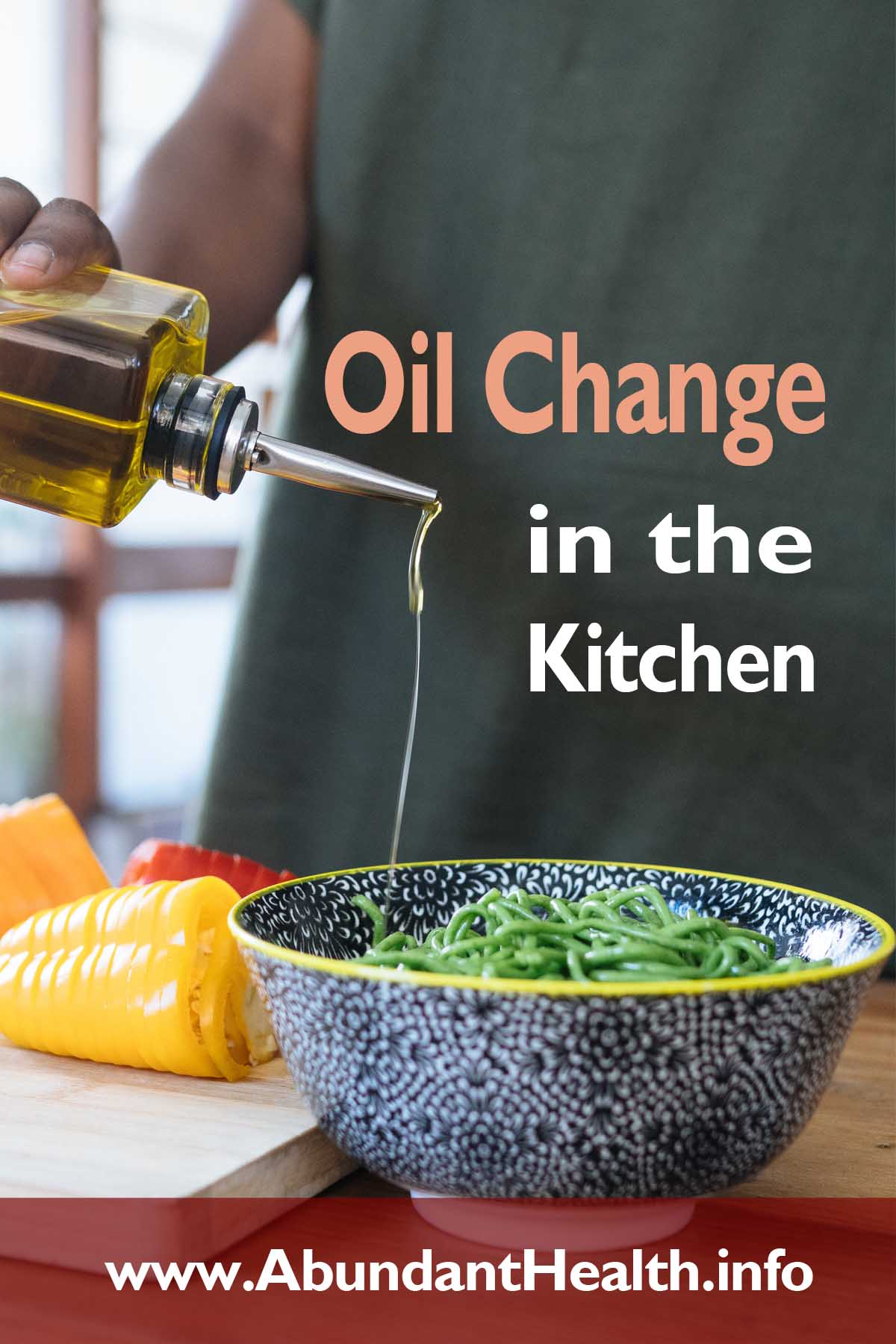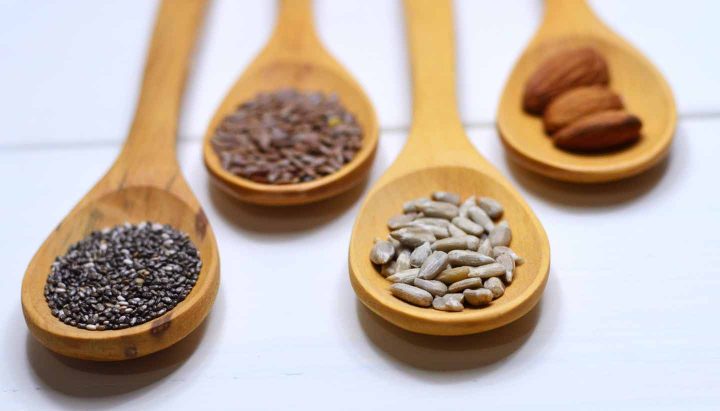The battle around fat has been going on for decades. Let’s remember the hot debate about whether to put butter or margarine on bread. The housewife wrings her hands and asks herself which oil to put on the salad. There are a number of low fat products that are in vogue right now. Then there’s the recommendation to eat fish twice a week for the omega-3 fatty acids that are heart and brain healthy. So at the end of the day, which fats shall we consume?

What is behind the terms Omega-3 and Omega-6? Fats and oils are made up of fatty acids. These are long compounds of carbon chains. In addition, one speaks of saturated and unsaturated fatty acids, whereby the unsaturated ones are the more valuable for our body. Unsaturated fatty acids have so-called double bonds. Omega-3 or -6 tells you where in the carbon chain the first double bond is located. It ranks third among the omega-3 fatty acids and sixth among the omega-6. Hence the designations. Omega tells the chemist which end of the fatty acid chain to count from. Both fatty acids are found in vegetable oils, but in different amounts.
Omega-6 Fatty Acids
Omega-6 fatty acids have 2 or 3 such double bonds. The best known are linoleic acid, gamma-linolenic acid (GLA) and dihomo-gamma-linolenic acid (DGLA). A fatty acid with 4 such double bonds that also plays an important role is arachidonic acid. But it is not essential. The body can produce it from linoleic acid.
Omega-6 fatty acids play an important role in building the double membrane of all cells and their organelles. They are particularly important for the elastic character and fluidity. So-called series 1 prostaglandins (also called eicosanoids) are formed in the body from DGLA. Prostaglandins are tissue hormones that are divided into numerous groups and subgroups. Their effects are diverse and sometimes contradictory. The prostaglandins of series 1 inhibit the aggregation of the blood platelets and thus the tendency to thrombosis. They promote sodium and water excretion via the kidneys and have an anti-inflammatory effect.
A lack of linoleic acid and GLA leads to eczema-like skin changes and hair loss. The liver metabolism is restricted and the kidney tissue degenerates. Heart and circulatory problems occur and growth disorders in children.
GLA and DGLA are not very common in our food and are mainly found in the seeds of borage, evening primrose and black currant. Linoleic acid is classically seen as promoting inflammation, but how far this holds true turned out to be recently a hot topic of discussion.1) Fritsche K L, Too much linoleic acid promotes inflammation—doesn’t it?, Prostaglandins, Leukotrienes and Essential Fatty Acids, Volume 79, Issues 3–5, 2008, Pages 173-175, https://doi.org/10.1016/j.plefa.2008.09.019.

Arachidonic acid, on the other hand, mainly produces series 2 prostaglandins in the body. These sometimes show opposite effects to the prostaglandins of the series 1. They are pro-inflammatory, promote salt and water storage and lead to high blood pressure.
A targeted supply of GLA-rich vegetable oils can promote the formation of prostaglandin 1 at the expense of prostaglandin 2 and thus prevent an increased tendency to inflammation and stress on the heart and circulatory system.
Animal products contain a lot of arachidonic acid, which we want to avoid. Pork lard contains extremely high values (1700 mg/100g), while dairy products contain around 50 mg/100g. On average, a meat eater consumes about 300 mg/day of arachidonic acid, which explains a multiplicity of inflammatory responses. Vegetarians take in practically no arachidonic acid, but a higher amount of linoleic acid, which consequently inhibits the synthesis of arachidonic acid.
Omega-3 Fatty Acids
Omega-3 fatty acids are the big stars protecting the heart and blood vessels. They reduce blood triglycerides, blood pressure and the risk of coronary heart disease. They probably also reduce the risk of developing Alzheimer’s disease and reduce certain rheumatic symptoms. They lower cholesterol levels and relieve neurodermatitis. They are essential for information processing in the brain. Omega-3 fatty acids inhibit the formation of endogenous pro-inflammatory pain mediators. The pain threshold is raised, the body only perceives pain at a higher “dose”. Hence the positive effect on rheumatic and other diseases such as psoriasis or neurodermatitis.
The omega-3 fatty acids include alpha-linolenic acid, eicosapentaenoic acid (EPA) and docosahexaenoic acid (DHA). They have similar functions as DGLA. From EPA the series 3 prostaglandins are formed. While these have a moderate promoting effect on platelet aggregation, they suppress the release of arachidonic acid from cell membranes, thus inhibiting the formation of prostaglandins 2. This is the basis of the anti-rheumatic, anti-inflammatory and heart-protecting effect of omega-3 fatty acids.
DHA is particularly important for the mental functioning and mental development of the embryo. The myelin, which is the white substance that covers the nerves, is especially rich in unsaturated fatty acids. A particularly large amount of DHA is also stored in the retina.
A lack of omega-3 fatty acids leads to growth disorders, disturbances in sensitivity, muscle tremors and blurred vision. It can also lead to increased triglyceride levels, which may be reduced by administration of fish oil preparations. The development of rheumatoid inflammation can also be suppressed by reducing the formation of prostaglandin 2.
Nevertheless, caution is advised against uncontrolled use of isolated omega-3 and omega-6 preparations such as evening primrose, borage and fish oils. Because the increased intake of unsaturated fatty acids also requires their protection. Especially people who are under high oxidative stress, like smokers, athletes, people with a lack of antioxidants such as vitamin C, E, A, carotenoids, can cause more harm than good through an excessive intake of unsaturated fatty acids.
The unsaturated fatty acids can oxidize and are thus converted into so-called free radicals before they can perform their biological function. They then migrate like bullets through the blood, tissues and organs and leave behind a radical chain reaction that destroy important structures such as membranes, vitamins or enzymes. An abundance of free radicals can even promote cancer.
If a fatty acid dietary supplement is planned, a sufficient supply of antioxidants should be ensured a few weeks beforehand. Incidentally, the same applies to carrying out a crash diet. The low calorie intake releases of course amongst others unsaturated fatty acids from the stored fat, which must also be protected by antioxidants.
A balanced diet with lots of fruits, vegetables, nuts, seeds and legumes naturally guarantees a balanced supply of essential fatty acids without putting any strain on the body.

A lack of essential fatty acids is rather rare, even though the consumption of Omega 3 fatty acids should be a bit more emphasized. The adipose tissue of a normal-weight, well-nourished adult can contain over 500 g of linoleic acid and 25 g of alpha-linolenic acid. A deficiency can occur with a fat-free artificial diet or with a chronic lack of fat intake.
Omega 3 Sources
Omega-3 fatty acids are found in vegetable oils and in the fish oil of cold-water fish, such as salmon, herring, mackerel, tuna, and sardines. Nutritionists recommend eating no more than five times as much omega-6 (linoleic acid) as omega-3 (linolenic acid). On average, however, the ratio is ten to one instead of five to one. How can we change that? We need to be more selective about our fat sources.
Linseed oil contains four times more linolenic acid (omega-3) than linoleic acid (omega-6). In addition, it contains plant substances that have an anti-cancer effect. Unfortunately, linseed oil has an unfavorable quality. Due to the large number of double bonds, it goes rancid very quickly. If we use linseed oil for our salad, we only buy small bottles and use the oil in three months at most. The bottle must be dark colored and stored in the refrigerator. These measures protect the valuable double bonds.
Freshly ground flaxseed can also be eaten instead of flaxseed oil. We can grind the flaxseed in a coffee grinder ourselves. As long as the seed is intact, the fat it contains with its many double bonds is also protected. After grinding, flaxseed should be used in a couple of days. We can sprinkle crushed flaxseed over salad, stir it into soups, add it to muesli and yoghurt, bake it in biscuits and bread.

Flaxseed is so valuable that it should actually be sold in pharmacies – alongside the cholesterol-lowering drugs. Every year billions of dollars are spent on medication to keep the cholesterol levels low. In most cases, a tablespoon of flaxseed oil would do the trick, and there wouldn’t be the usual side effects.
But at the same time we have to make sure that we get enough vitamins from the antioxidant group to protect the valuable double bonds in fat. Because even in the body they can still be destroyed. These are vitamin E, vitamin A, carotenoids and vitamin C. They are all found in fresh fruit and vegetables.
Another interesting source of omega-3 is hemp oil. It contains a lot of vitamin E and therefore has a longer shelf life than linseed oil. It also contains cholesterol-like substances that can lower cholesterol levels. You don’t need to be afraid to get a high, since the tetrahydrocannabinol (THC) has been bred out of hemp plants. Hemp oil also counteracts inflammatory processes and is used in skin diseases such as neurodermatitis and psoriasis. The omega-6 to omega-3 ratio is about 3:1.
Canola oil also has a favorable ratio, about 3:1. Today’s canola oil no longer contains erucic acid and is no longer chemically extracted for food purposes. But it is rarely offered unrefined.
Walnut oil has a 5:1 ratio. The nutty aroma goes well with almost all salads. Eating a handful of nuts every day is very healthy because nuts also contain many minerals, vitamins and lecithin. Fat from nuts does not make you fat because it does not get into the fat cells at all, but is converted into much more valuable substances in the body. If we eat a few nuts every day, we are doing something good for our health.
Frequently we hear the recommendation to eat fish twice a week – because of the protective effect on the heart. Unfortunately, there are already many pollutants in fish today, especially mercury, which cancels out the protective effect. It even promotes depression. Sales of fish oil capsules are also booming. When consumed at all, verify at least if the fish oil has been purified. But we also get along without fish, as we have shown above with the vegetable oils.

Stay Always Up to Date
Sign up to our newsletter and stay always informed with news and tips around your health.

Esther Neumann studied Nutrition at the University of Vienna. Since then she served as an author for the health magazine “Leben und Gesundheit” and conducted health lectures in various locations of Austria.
References
| ↑1 | Fritsche K L, Too much linoleic acid promotes inflammation—doesn’t it?, Prostaglandins, Leukotrienes and Essential Fatty Acids, Volume 79, Issues 3–5, 2008, Pages 173-175, https://doi.org/10.1016/j.plefa.2008.09.019. |
|---|
Thank you, Esther, for the enlightening article. What about olive oil?
Yes, olive oil is not the best option in regard to Omega 3 content. It is still valuable because it normally comes cold pressed, maintaining some valuable phytochemicals and other substances. So as long as you do not heat it, it is a good option for your salad.
Speaking about oils. I find a lot of controversy with coconut oil… could you share some info on this?
Yes, just like you say it is controversial. Coconut is mostly saturated fat, but considering that it is a medium chain fatty acid, it is metabolized slightly differently than long chain animal fats. Some say it is lowering cholesterol. In practice, most of the time we observe it is raising cholesterol, and that is what most experts believe, although in the absence of oxidized cholesterol from animal sources, it is hardly causing any arterial damage. Now for cooking or frying, it is surely the best choice, since it is very stable. Try to do frying with olive oil, and you have something quite carcinogenic.